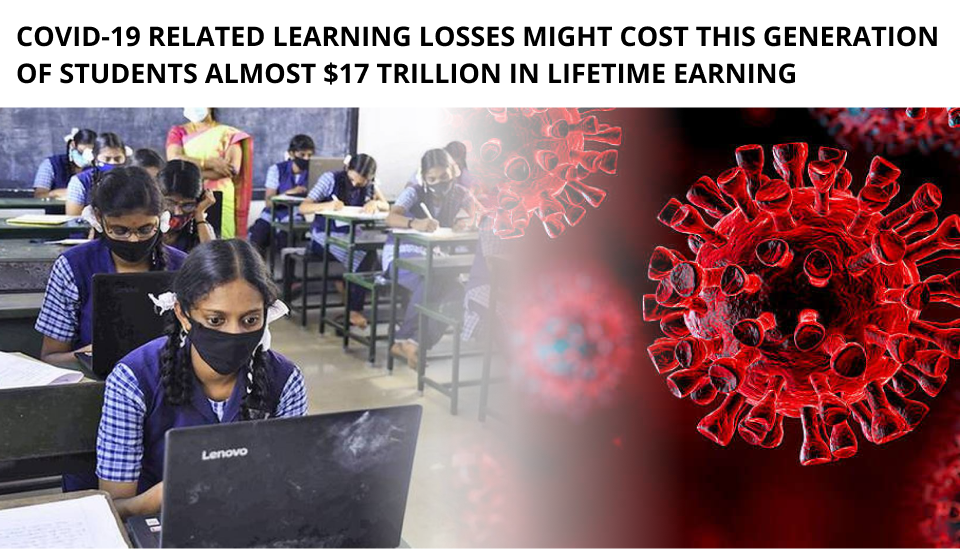Key Takeaways:
- According to research released by the World Bank, UNESCO, and UNICEF, COVID-19-related learning losses might cost this generation of students almost $17 trillion in lifetime earnings.
- Fewer than 3% of government stimulus packages have been dedicated to education. For immediate learning recovery, much more money will be required.
- While nearly every country in the world provided students with remote learning options, in most cases, they offered only a partial substitute for in-person education.

According to findings released today by the World Bank, UNESCO, and UNICEF, this generation of students is now at risk of losing $17 trillion in lifetime earnings in present value, or roughly 14% of today’s global GDP, as a result of COVID-19 pandemic-related school closures.
The new estimate shows that the impact will be significantly more than previously estimated, exceeding the $10 trillion estimates given in 2020.
Furthermore, according to The State of the Global Education Crisis: A Path to Recovery report, the proportion of children living in Learning Poverty in low- and middle-income countries, which was already at 53% before the pandemic, could rise to 70% due to lengthy school closures and the ineffectiveness of remote learning in ensuring complete learning continuity during school closures.
“The COVID-19 crisis brought education systems across the world to a halt,” stated Jaime Saavedra, World Bank Global Director for Education. “Now, 21 months later, schools remain closed for millions of children, and others may never return to school. The loss of learning that many children are experiencing is morally unacceptable. And the potential increase of Learning Poverty might have a devastating impact on future productivity, earnings, and well-being for this generation of children and youth, their families, and the world’s economies.”
Accurate data is now correlating simulations estimating that school closures resulted in severe learning losses.
Regional evidence from Brazil, Pakistan, rural India, South Africa, and Mexico, among others, shows significant declines in math and reading. According to research, learning losses are roughly proportionate to the shutdown length in several nations.
However, there was significant variation across nations and by subject and in terms of students’ socio-economic situation, gender, and grade level.
“The estimated learning losses were greater in math than reading, and affected younger learners, students from low-income backgrounds, as well as girls disproportionately,” as per the report.
With a few exceptions, accumulating evidence from around the world supports the findings from Mexico, implying that the crisis has increased educational inequality.
Children from low-income families, children with impairments, and girls were less likely to employ remote learning than their peers. In addition, younger students, especially those in critical learning and development periods, had less access to remote education and were more affected by learning loss than older students.
The most marginalized or vulnerable (lower socio-economic status in countries like Ghana, Mexico, and Pakistan.) people have been disproportionately affected by the negative influence on learning.
According to preliminary findings, girls are losing the safety that schools and learning provides to their well-being and life opportunities.
Countries should consider the following factors to construct more long-term resilient education systems:
- Investing in the enabling environment so that all students can benefit from digital learning opportunities.
- Parental, family, and community involvement in children’s learning is emphasized.
- Providing support and access to high-quality professional development options for instructors and increasing the proportion of stimulus funds allocated to education in the national budget.
Cryptocurrencies have grown in popularity as a result of the decentralization ideas they promote, as well as the possibility for significant returns. Still, their volatility remains strong, and these assets have a higher risk of loss than many traditional assets.
Currently, roughly 56% of the world’s top 50 institutions offer at least one blockchain or cryptocurrency-related course. This figure increased from 42% in 2018 to 43% in 2019 – indicating moderate but consistent development.
Coinbase also provides another piece of data that demonstrates the demand for such initiatives:
“Twice as many students report having taken a crypto or blockchain course than they did in 2018.”
Blockchain Education is in High Demand
Students can now study cryptocurrency or blockchain at up to 56% of the world’s leading universities. Multiple blockchain classes are available at UC Berkeley and Stanford, but Cornell University provides the most options, including “Introduction to Blockchain, Cryptocurrencies, and Smart Contracts” and “The Anthropology of Money.”
Students are curious about the value and characteristics of blockchain and cryptocurrencies, in addition to their monetary value. They’re especially interested in real-world applications.
The blockchain challenges standard legal concepts and classifications, which could be immensely relevant for individuals who study law in the next years. Furthermore, from the standpoint of the nature of money, blockchain and cryptocurrencies are a topic of interest for students in economics and business institutions. Some even consider Bitcoin to be the next phase in the evolution of money.











